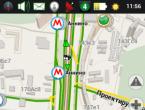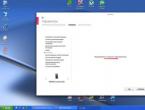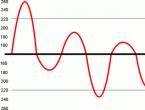System defragmentation. How to do a quick or full disk defragmentation on Windows: all programs and methods
Hi all! I think many have noticed that over time the computer starts to work more slowly ... it seems that they installed the program, deleted it - but in the end there is no program, but the brakes remain. One reason is disk fragmentation. If you have an SSD drive, then you can not read this note - defragmentation is not needed there, but on the contrary - it can even harm your computer.
When you install a program on your computer, copy some new movie or download music from the Internet, the pieces of this data are not written sequentially, but on empty sections of the hard disk, and sometimes very far from each other. This situation is called data fragmentation ... and if there are a lot of such sections, then the computer starts to work much slower. Therefore, if you have never done defragmentation, then periodically performing it can increase the performance of your computer.
In our situation, we need to arrange all the data so that they are most conveniently located for reading (which is why when you divide a disk, the execution time of this operation varies), after everything is in order, not only the speed of reading from disks will increase, but in general, the operation of the system.
The defragmentation process can take different times - it all depends on your computer and the degree of fragmentation of your data, usually from several minutes to many hours ... in general, each case is individual.
The Windows system has standard services for defragmentation, we do not have to install anything (however, the network is full of programs specifically designed to defragment disks)... for this you need to right-click on the local disk and select "Properties" there.

In properties local disk select the "Service" tab and find the item "Perform defragmentation" there - that's what we need.

Here we first want to analyze, and then decide whether to defragment or not? If fragmentation is present, then we do it, and perhaps you don’t have problems - why should the computer be loaded with extra work?

Right (directly from the checkout), you can set a schedule ... for example, I don’t turn off the computer at night and defragmentation is performed while I sleep ... so it doesn’t bother me at all, which is why I can’t say how long this process takes me, since I don’t take part in it .
Disk defragmentation is a procedure for combining fragmented files, which is mainly used to Windows optimizations. In almost any article on speeding up your computer, you can find advice on defragmenting.
But far from all users understand what defragmentation is, and do not know in which cases it should be done and in which not; what software should be used for this - is the built-in utility enough, or is it better to install a third-party program.
When doing disk defragmentation, many users do not even think or try to find out what it is all about. The answer can be found in the name itself: “defragmentation” is a process that combines files that, when written to a hard disk, were divided into fragments. The image below clearly shows that on the left, fragments of one file are recorded in a continuous stream, without empty spaces and divisions, and on the right, the same file is scattered across the hard disk in the form of pieces.

Naturally, it is much more convenient and faster for a disk to read a continuous file than one separated by white space and other files.
Why HDD Fragmentation Happens
Hard drives are made up of sectors, each of which can store a certain amount of information. If a large file that cannot fit into one sector is stored on the hard drive, it is split and saved into several sectors.
By default, the system always tries to write file fragments as close as possible to each other - in neighboring sectors. However, due to the deletion / saving of other files, resizing of already saved files and other processes, there are not always enough free sectors located next to each other. Therefore, Windows moves the writing of the file to other parts of the HDD.
How Fragmentation Affects Drive Speed
When you need to open a recorded fragmented file, the hard drive head will sequentially move to the sectors where it was saved. Thus, the more times it has to move around the hard drive in an attempt to find all the pieces of the file, the slower the reading will be.
The image on the left shows how many movements the hard drive head needs to make in order to read files that are divided into parts. On the right, both files, indicated in blue and yellow, are recorded continuously, which significantly reduces the number of movements on the disk surface.

Defragmentation is the process of rearranging pieces of one file so that the overall percentage of fragmentation decreases, and all files (if possible) are located on adjacent sectors. Due to this, reading will occur continuously, which will positively affect the speed of the HDD. This is especially noticeable when reading large files.
Does it make sense to use third-party defragmentation programs?
The developers have created a large number of defragmentation programs. You can find both small defragmenter programs and meet them as part of complex system optimizers. There are free and paid options. But are they needed?
A certain effectiveness of third-party utilities is undoubtedly present. Programs from different developers may offer:
- Own auto-defragmentation settings. The user can more flexibly manage the schedule of the procedure;
- Other algorithms for the process. Third-party software has its own features that are more beneficial in the long run. For example, they charge less interest free space on the HDD to run the defragmenter. At the same time, files are optimized to increase their download speed. The free space of the volume is also merged so that the level of fragmentation increases more slowly in the future;
- Additional features, for example, registry defragmentation.
Of course, the functions of the programs vary depending on the developer, so the user needs to select the utility based on their needs and PC capabilities.
Is it necessary to permanently defragment the disk?
All modern Windows versions offer automatic carrying out of this process according to the schedule once a week. All in all, it's more useless than necessary. The fact is that fragmentation itself is an old procedure, and in the past it really was constantly needed. In the past, even slight fragmentation has already had a negative impact on system performance.
Modern HDDs have more high speed work, and new versions of operating systems have become much “smarter”, so even with a certain fragmentation process, the user may not notice a decrease in speed. And if a hard drive with a large volume (1 TB or more) is used, then the system can distribute heavy files in an optimal way for it so that this does not affect performance.
In addition, the constant launch of the defragmenter reduces the life of the disk - this is an important minus that should be taken into account.
Since defragmentation is enabled by default in Windows, it must be disabled manually:

Is it necessary to defragment an SSD drive?
A very common mistake for users using SSDs is to use any defragmenter. Remember, if you have an SSD installed on a computer or laptop, in no case do not defragment it - this greatly speeds up the wear of the drive. In addition, this procedure will not increase the speed of the SSD.
Features of defragmentation
There are several nuances for the quality of this procedure:
- Despite the fact that defragmenters can work in background, for achievement best result it is best to run them when there is no activity on the part of the user, or with a minimum amount of it (for example, during a break or while listening to music);
- When conducting periodic defragmentation, it is more correct to use fast methods, speeding up access to the main files and documents, however, a certain part of the files will not be processed. The full procedure in this case can be done less frequently;
- Before a full defragmentation, it is recommended to remove junk files, and, if possible, exclude files from processing. pagefile.sys And hiberfil.sys. These two files are used as temporary files and are recreated with each system startup;
- If the program has the ability to defragment the file table (MFT) and system files, then you should not neglect it. As a rule, such a function is not available when the operating system is running, and can be performed after a reboot before starting Windows.
How to defragment
There are two main ways to defragment: installing a utility from another developer or using a program built into the operating system. In this case, you can optimize not only the built-in drives, but also external drives connected via USB.
Our website already has instructions for defragmenting using Windows 7 as an example. In it you will find a guide for working with popular programs and a standard Windows utility.
- Do not defragment a solid state drive (SSD).
- Disable scheduled defragmentation in Windows.
- Do not abuse this process.
- First, do an analysis and find out if there is a need to perform defragmentation.
- If possible, use high-quality programs whose efficiency is higher than the built-in Windows utility.
Defragmentation is a process for combining different fragments of files located on a computer's hard drive.
During prolonged use of the computer, some files on the hard drive are subjected to strong fragmentation- division of one file into several parts located in different sectors of the disk partition. For this reason, the computer has to spend much more time to find and run the desired program for the user. It turns into a strong performance drop systems, brakes and freezes of computer games or programs and other problems in the operation of a personal computer.
For the correct sorting of files on hdd, defragmentation is used, during which files are distributed over evenly on the disk partition, which will greatly speed up access to necessary files, because the magnetic head hard drive you no longer have to jump wildly on the surface of the drive.
How long does the process take
This process occupies an impressive amount of time, depends on volume, occupancy and speed hard drive. Some half empty HDD 500 gigabytes will be fully defragmented in a couple of hours, and maybe even faster.
Full disks of a huge volume of several terabytes will undergo a very long procedure (in some cases it takes more than ten hours). It takes such an impressive time due to the fact that in the process it constantly happens transfer files and overwriting literally the entire hard drive, which for obvious reasons takes a very long time.
The more free space on the hard drive, the faster and better the process will be performed. That is why before starting this process recommended free at least 15 percent drive, because in this case, defragmentation will be much faster than on an overcrowded media.
Is it possible to defragment drive C
defragmentation system partition(or drive C) do Can. This process is absolutely safe in terms of the risk of harming system files or directories. Firstly, the process does not delete any files, they just move to another place on the disk. Secondly, the procedure does not affect system files or directories, they do not change at all during the process of optimizing the hard disk.
So do not be afraid to defragment the hard disk partition where you installed operating system. The exception is drive C, which is located on a solid state drive, but more on that in the next paragraph.
Is it worth it to defragment an SSD?
Solid State Drives not subject to fragmentation. Due to the lack of moving parts, SSDs work with any files at the same speed, no matter how they are located on the partition.
SSD defragmentation is not only useless, but also destructive for this type of storage. The reason for this lies in the type of memory used on solid state drives. Unlike standard hard drives, the SSD uses flash memory that has limited cycles overwrites, after which no new files can be written to the disk. Carrying out the procedure will greatly reduce the overall life of the SSD, so do it categorically Not recommended.
Disk Defragmenter
Operating systems have a built-in utility for defragmenting and optimizing partitions, so installation third party applications not required. Go to this program There are several ways, but first things first.
Using standard operating system tools




- After that, it remains only to wait for the end of the process.
Using the schedule
In Windows 8.1 and Windows 10, you can set up scheduled hard disk optimization. To do this, in a previously familiar utility, you will need to click on the menu button " Change settings»; 
After that, it remains only to choose once in what period to perform automatic defragmentation and the necessary for this procedure hdd.
Attention! Before enabling the scheduled process, you should make sure that the checkboxes are unchecked from the SSD drives in the settings, otherwise they will become unusable very quickly!
Defragmentation via command line
Fans of something more complicated can try to start the process exclusively through command line .
To go to the command line, press the key combination " Windows» + « R", and in the window that appears, enter " cmd».  To get a list of the necessary commands, you should type in the window that appears " defrag/?". After that, the command line will display information about all commands, allowing you to defragment your hard drive.
To get a list of the necessary commands, you should type in the window that appears " defrag/?". After that, the command line will display information about all commands, allowing you to defragment your hard drive.  Defragmentation via the command line is needed exclusively for use additional features, inaccessible through standard utilities. If you do not have sufficient knowledge of personal computers, it is better not to use this method once again.
Defragmentation via the command line is needed exclusively for use additional features, inaccessible through standard utilities. If you do not have sufficient knowledge of personal computers, it is better not to use this method once again.
What is disk defragmentation?
Disk Defragmenter is the process of consolidating fragmented files on a hard drive.
Files on a hard drive become fragmented over time, whether they are saved, modified, or deleted. The changes made to the file are saved to other sectors of the hard disk, remote from the location of the original file. Over time, fragmentation affects not only the file, but the entire hard drive. This slows down the work, since to open the file you have to read information from different places on the hard disk.
What is Disk Defragmenter?
A large degree of file fragmentation forces the hard drive to perform additional actions, which slows down the work. Disk defragmenter organizes fragmented files for better effective work, that is, a disk defragmenter program is needed to increase performance.
IN Windows there is a built-in Disk Defragmenter: Windows XP – \WINDOWS\system32\dfrg.msc; 40,1KB; Windows Vista – \Windows\System32\dfrgui.exe; 630KB. Third-party developers can also be used to defragment a disk.
Disk defragmenter can run automatically (according to a set schedule), but you can also run defragmentation manually.
How to run disk defragmenter manually
Click My computer –> select the desired disk;
– right button call –> Properties;
- in the opened window Properties open tab Service;
- In chapter Disk Defragmenter button Run a defrag…;
- in the opened window Disk Defragmenter press the button defragmentation;
- Wait for the defragmentation process to finish.
You can start defragmentation in another way: Start –> Settings –> Control Panel –> Administrative Tools –> Computer Management –> Disk Defragmenter –> select the desired disk –> Defrag.
Notes
1. It is advisable to defragment the disk at least once a month.
2. Defragmentation not only improves performance and speed, but also allows you to extend the life of the hard drive.
3. Before defragmenting, it is advisable to perform a disk check.
4. Depending on the size of the disk and the degree of file fragmentation, defragmentation may take from several minutes to several hours.
5. Although in modern defragmentation work can not be interrupted, it is still better not to do anything else during defragmentation. Therefore, it is convenient to run defragmentation during idle time, for example, at night.
6. Experienced can use the command line tool defrag.exe (Disk Defragmenter Module; \WINDOWS\system32\defrag.exe; 69,0KB) to generate detailed reports and perform additional tasks.
For this:
– press Start –> Run… –> Run program –> cmd –> OK;
- will start Interpreter Windows commands ;
- switch (if necessary) keyboard layout to EN;
– after the system prompt C:\Documents and Settings\Administrator> enter the command defrag with the necessary keys:
defrag<том>[-a] [-f] [-v] [-?]
volume– Drive letter or mount point (for example, d: or d:\vol\mpoint)
-a– Analysis only
-f– Defragmentation even with limited disk space
This is a process during which the location of files on the disk is optimized. This optimization allows you to increase the speed of working with files, and therefore improve the performance of your computer as a whole. In this article, we will talk about how to defragment a disk using the tools built into Windows, as well as using third-party programs.
Tips for performing defragmentation:
- Do not defragment drives. For SSD drives defragmentation is absolutely useless. It only reduces the resource SSD drive, while not giving any gain in speed.
- To perform defragmentation, you need free disk space. The more free space, the faster and better the disk defragmentation will be performed. The minimum amount of available space is 15 percent of the entire disk.
- If you want to get consistently high speed, then use scheduled defragmentation.
- Try not to use a disk that is being defragmented.
How to do disk defragmentation using Windows
operating room Windows system has a built-in mechanism for disk defragmentation. In order to use it, open "My Computer" and call the properties of the partition you want to fragment.
In the window that opens, go to the "Tools" tab and click on the "Defragment" button.

After that, the "Disk Defragmenter" window will open in front of you. Here you need to select the disk that you want to fragment and click on the "Analyze disk" button.

After the analysis of the selected disk is completed, you will see the percentage of fragmented data on the disk. If this percentage is significant, then you need to defragment. For example, I analyzed disk "E" and the percentage of fragmented data on it is zero. You do not need to defragment this drive. But after analyzing the “C” drive, it turned out that it was fragmented by 36 percent, which means it needs to be defragmented.
In order to defragment drive “C”, select it in the list of drives and click on the “Disk Defragmenter” button.

After that, the defragmentation process will begin. The time it takes to defragment a disk depends on the amount of defragmented data and the speed of the disk itself. As a rule, this takes at least several hours.
In addition to manually starting defragmentation, you can use scheduled start. To do this, in the "Disk Defragmenter" window, click the "Enable Schedule" button.

After that, you will see a small window "Disk Defragmenter: Reschedule". Here you need to enable the “Run according to a schedule” function and set up a schedule.

Defragmentation can be performed daily, weekly, and monthly. After setting the schedule, close all windows by clicking on the "OK" button.
Disk defragmentation using third-party programs
You can also defragment your disk with third party programs. Now there are many quality ones. Of the free ones, the most popular are Piriform Defragger, Auslogics Disk Defrag, MyDefrag, IObit Smart Defrag. Paid programs much more, the most famous of them are: O&O Defrag, Ashampoo Magical Defrag, Raxco PerfectDisk, Auslogics Disk Defrag Professional.
For example, consider the process of defragmenting a disk using free program Auslogics Disk Defrag Free.
After starting the program, check the boxes next to the disks you want to defragment and start analyzing them.

After analysis, the program showed that the C drive was 46 percent fragmented. In order to defragment this disk, check the box and click on the "Defrag" button.

This is all that needs to be done, it remains only to wait for the end of the defragmentation process.
Like the built-in defrag utility, Auslogics program Disk Defrag Free allows you to perform scheduled disk defragmentation. To do this, open the "Settings" menu and select the "Scheduler" item.

After that, a window with the defragmentation schedule will open. Here you need to enable the "Defragment automaticaly" function, select the defragmentation time and disks.

After that, Auslogics Disk Defrag Free will perform defragmentation automatically at the specified time.




